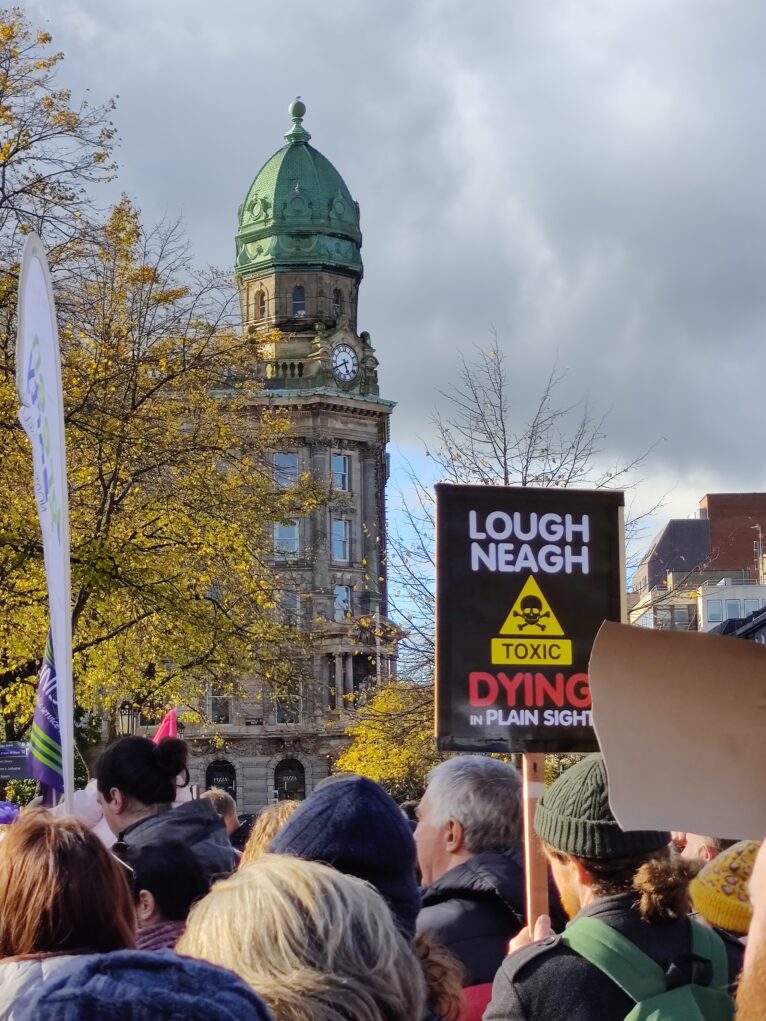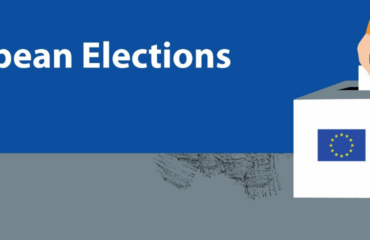What is the death of Lough Neagh an example of?

Lough Neagh, the largest freshwater lake in the UK and Ireland is dying. Eutrophication and ensuing wide-spread cyanobacteria bloom have seen the Lough turn bright green this summer, killing wildlife and stopping economic activity such as fishing and tourism. NI residents, both on its shore and beyond are worried about what this means for the quality of drinking water in Northern Ireland. 40 percent of NI waters come from the Lough.
Eutrophication is always a complex problem which is hard to fix. It is caused by an overabundance of nutrients which come from different sources. Reducing the flow of nutrients is needed – but the existing high stock of nutrients in the lough (nitrates and phosphates) means that improvement in the water quality of the lough will take a very long time. In Lough Neagh the situation is made worse by the growing presence of an invasive species, zebra mussels, which filter the water allowing more light into the lough, spurring algae growth.
This post tries to make sense of the environmental crisis in Lough Neagh. It advances three arguments. First, that while dramatic, the situation in Lough Neagh is far from unique and as in comparable cases, it has developed over decades. Second, that the crisis reveals the fractures, failures and tensions within environmental governance in Northern Ireland. Third, that the long-standing and muddled nature of the crisis means that any answer to “who killed the Lough” needs to be multi-faceted – which will make any efforts to address the crisis complex (but nevertheless urgently needed).
An extreme event – but a common problem slowly building over time
In the recent state of Lough Neagh we find tensions common in eutrophication cases between the industries that cause it (from farming to urban waste water treatment) and the industries undermined by algae blooms (from tourism to fishing). These tensions are common, from Venice to Brittany.
This crisis was a long time coming. In the case of Lough Neagh as in the Breton case we can find years, indeed decades, of environmental complaints about mismanagement to both local authorities and the European Commission leading to some limited governmental responses. In both cases we can also find local mobilization against algae blooms but also against extractive industry (sand extraction in the Lough and on the Breton coast). But Lough Neagh does stand out due to the incredible superposition of private ownership and public interest which makes it a fascinating case to consider rights of nature.
While the problem is not new nor unique, the blooms were particularly dramatic this summer. This occurred at a particularly bad time: the Northern Irish Executive and Assembly are still missing in action, making it difficult to know who can be held accountable for the dying lough.
What Lough Neagh reveals about NI environmental governance
The Lough Neagh crisis is a perfect case to take stock of the dispersed and complex nature of environmental governance in Northern Ireland. It sits at the interface of planning (quality of urban waste water treatment, authorization to establish or expand farms), general economic strategy and agricultural policy in NI (the ‘Going for Growth’ strategy which prioritized growth in agri-food), water protection and biodiversity strategies (including all-island efforts to tackle invasive species). Or in other words, it sits between the local Councils (4 out of the 11 NI Councils border the Lough) granting planning applications, the Department for Infrastructure (DFI, which oversees the planning process), the Department for Agriculture, Environment and Rural Affairs (DAERA, which oversees agriculture and environmental policy) and the NI Environment Agency (overseeing the application by private actors of those later two policies).
The crisis is also a useful challenge to any rose-tinted view of EU environmental governance. Lough Neagh was mentioned in a number of cases brought to the Commission and the Court of Justice by environmental groups (on sand dredging, on urban waste water treatment) – yet as in the Breton case, repeated involvement of EU regulators did not solve the issue.
Who is killing the lough?
When over the summer people started asking if Lough Neagh is dying, who is killing the Lough, the simplest answer is death by a thousand cuts. Lough Neagh’s death is not a question of either/or for responsibilities – either the Councils or farmers or DAERA or DFI – but a matter of and: the Councils and farmers and the civil service and sand extraction, and our general extractive approach to the environment as a society etc. This makes sorting the issue much more complex than simply nationalizing the lough – although this active discussion can be a useful starting point to discuss both what a rights for nature approach would look like in Northern Ireland and to discuss how we could try to connect the different public actors impacting the lough to work together in a coherent way.
Another way to look at it is: cock-up or conspiracy? Negligence or malfeasance? While the Lough Neagh crisis is a perfect example of the danger of a lack of joined up thinking and environmental policy integration into planning and agriculture policy development and implementation; a new environmental scandal in Northern Ireland is shedding a different, more pernicious light.
Once more, it is not a matter of either/or but both: cock-up and conspiracy, negligence and malfeasance. Thus, it has now come to light that at least 108 farm planning applications, many of which were close to the Lough or to tributaries to the Lough, were based on fraudulent applications. Two types of fraud – the use of fake soil sample to make case that soil was able to receive more nutrients; the falsification of letters from the Irish agri-food agency, Teagasc, purporting to argue an agreement to export waste to the Republic – have been found, casting serious doubt on the way growth in the NI agri-food sector is being managed and the repeated downplaying of its environmental cost. NIEA informed 9 Councils of the use of fake soil sample – but it is now in the hands of the Councils to act on this and rescind planning applications.
Where does this leave NI environmental governance? As with Lough Neagh, there is no quick fix. Greater integration and cooperation is needed, between the different bodies in charge – and environmental objectives need to move further up the list of priorities. In this case the new Office for Environmental Protection may help – but it is a daunting task for what is quite a small body, with still to be tested powers. The current crisis demonstrates once more that you can only ignore and damage the environment for so long before you flirt with ecosystem breakdown, and undermine the very basis of economic activity (and life) in Northern Ireland. In the absence of government in NI it is up to the governed to take on the task of holding decision-makers – in the Councils, in the civil service – accountable and demand better, urgently.




